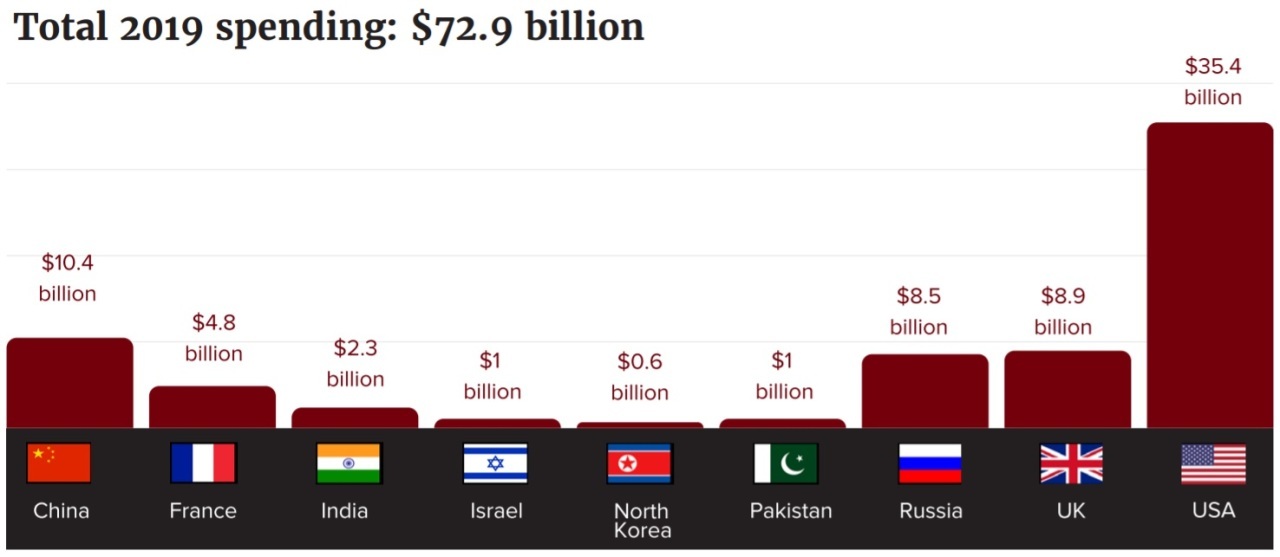
FY 2021 Presidential Budget for NNSA Released
National Nuclear Security Administration
WASHINGTON — The US Department of Energy’s National Nuclear Security Administration (DOE/NNSA) released its portion of the President’s Fiscal Year (FY) 2021 Budget Request today.
The President’s $19.8 billion FY 2021 budget request is an increase of $3.1 billion – or 18.4 percent – above the FY 2020 enacted level to fund NNSA’s mission pillars: maintaining the safety, security, and effectiveness of the nuclear weapons stockpile; reducing the threat of nuclear proliferation and nuclear terrorism around the world; and providing nuclear propulsion to the US Navy’s fleet of aircraft carriers and submarines.
“The FY 2021 budget request is a reflection of the President’s strong commitment to ensuring the Nation has a safe, secure and effective nuclear deterrent for many decades,” said Lisa E. Gordon-Hagerty, DOE Under Secretary for Nuclear Security and NNSA Administrator. “This funding also affirms the Trump Administration’s continued work in reducing the threat posed by nuclear proliferation and terrorism, and commitment to safely and effectively powering the Nuclear Navy.”

Click here to see presentations supporting current and past budget proposals.
Budget Highlights:
The Weapons Activities’ budget request ($15.6 billion) is 25.2 percent above the FY 2020 enacted level to meet the Administration’s goals to modernize the Nation’s nuclear weapons stockpile and infrastructure after decades of neglect. The request enables NNSA to:
• Continue to meet requirements outlined in the 2018 Nuclear Posture Review
• Sustain and modernize the US nuclear weapons stockpile with five weapons programs, including the B61-12 Life Extension Program, W80-4 Life Extension Program, W88 Alteration 370, W87-1 Modification Program, and the W93 warhead program. The W93 warhead program was recently endorsed by the Nuclear Weapons Council and the Deputy Secretary of Defense to support the US Strategic Command-required replacement for the Navy’s Trident II D5 submarine launched ballistic missile (SLBM)
• Execute stockpile sustainment activities including maintenance, surveillance and assessment to ensure that all weapons remain operational
• Conduct Annual Assessment activities for all weapon systems including the in-depth testing and analysis of systems, subsystems, and components
• Execute dismantlement and disposition of weapons and components for weapons retired from the stockpile
• Support production modernization activities for non-nuclear components and strategic materials, including a two-site plutonium pit production strategy at Los Alamos National Laboratory and Savannah River Site that will meet Department of Defense requirements
• Recapitalize NNSA’s aging infrastructure, including the Uranium Processing Facility at Y-12 National Security Complex, the U1a Complex Enhancements Project at the Nevada National Security Site, and the High Explosive Science and Engineering Facility at the Pantex Plant
• Invest in Exascale computing, Enhanced Capabilities for Subcritical Experiments, and other experimental capabilities to support weapons assessment and certification

The Defense Nuclear Nonproliferation budget request ($2 billion), after adjusting for the one-time $220 million appropriation for the Mixed Oxide (MOX) Fuel Fabrication Facility closeout in FY 2020, is $87 million (4.5 percent) higher than FY 2020’s enacted level. This reflects the Administration’s commitment to nonproliferation programs. The budget request enables NNSA to:
• Pursue additional opportunities to minimize and, where possible, eliminate weapons-usable nuclear material around the world
• Support US industry partners to establish a reliable commercial supply of Molybdenum-99 produced without highly enriched uranium (HEU)
• Build domestic and international capacity to secure nuclear and radioactive material and prevent nuclear smuggling
• Advance capabilities for detecting and monitoring foreign nuclear material and weapons production activities, material security, and nuclear explosion monitoring, with an emphasis on testbed development and targeted, long-term efforts ensuring technical capabilities
• Provide analytical and technical support to the International Atomic Energy Agency (IAEA) to further US nonproliferation, threat reduction, and peaceful uses goals through the IAEA’s nuclear security and safeguards mission
• Provide enhanced diagnostic, technical, and assessment operations in support of the FBI’s growing regional capability to respond to nuclear and radiological threat devices
• Sustain Nuclear Emergency Support Team (NEST) activities, and NEST equipment recapitalization, including procurement of two Aerial Measuring System rotary-wing aircraft
• Administer emergency management program across DOE, including the Department’s 24/7 Emergency Operations Center
The Naval Reactors budget request ($1.7 billion) is 2.2 percent above the FY 2020 enacted level. The budget request enables NNSA to:
• Provide core support for the safe and reliable operation of the US Navy’s nuclear fleet – 68 submarines; 11 aircraft carriers; and 4 research, development, and training platforms – that account for over 40 percent of the Navy’s major vessels
• Support three critical modernization efforts: the Columbia-Class Reactor System Development, the Land-based S8G Prototype Refueling Overhaul, and the Spent Fuel Handling Recapitalization Project
The Federal Salaries and Expenses budget request ($454 million) is 4.4 percent above the FY 2020 enacted level and supports recruiting, training, and retaining the highly skilled federal workforce. NNSA must have sufficient staffing, with the right capabilities to ensure NNSA can modernize the nuclear deterrent, recapitalize an aging infrastructure, and continue to meet the requirements of our nonproliferation and counterterrorism programs. The request supports 1,858 federal employees.
NATIONAL NUCLEAR SECURITY ADMINISTRATION: 1000 Independence Ave., S.W., Washington, DC 20585
Posted in accordance with Title 17, Section 107, US Code, for noncommercial, educational purposes.